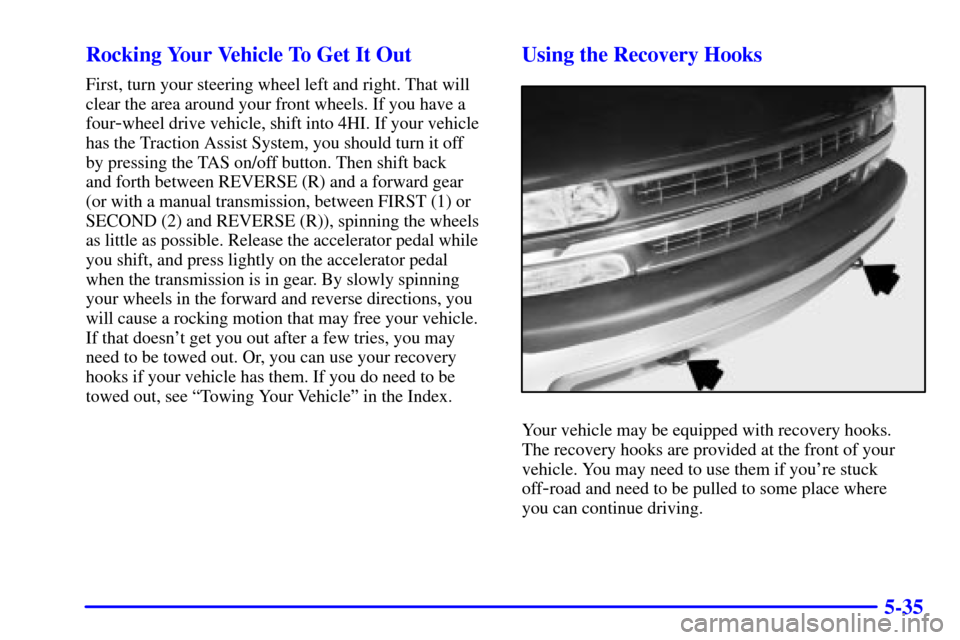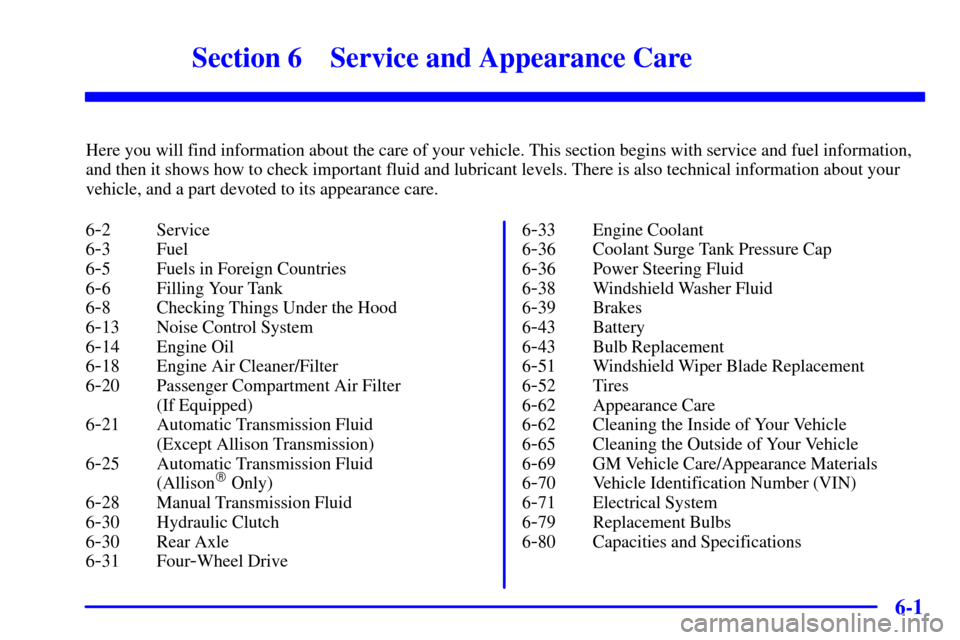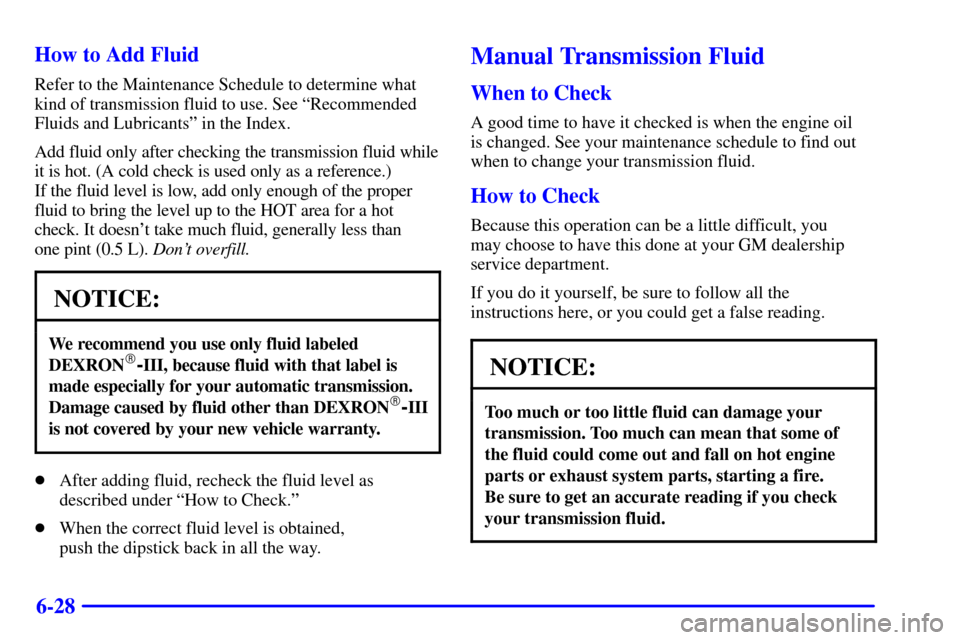Page 325 of 468
5-19
Changing a Flat Tire
If a tire goes flat, avoid further tire and wheel damage
by driving slowly to a level place. Turn on your hazard
warning flashers.
CAUTION:
Changing a tire can cause an injury. The vehicle
can slip off the jack and roll over you or other
people. You and they could be badly injured.
Find a level place to change your tire. To help
prevent the vehicle from moving:
1. Set the parking brake firmly.
2. Put an automatic transmission shift lever in
PARK (P) or shift a manual transmission
to FIRST (1) or REVERSE (R).
3. If you have a four
-wheel-drive vehicle,
be sure the transfer case is in a drive
gear
-- not in NEUTRAL.
CAUTION: (Continued)
CAUTION: (Continued)
4. Turn off the engine.
5. Put the wheel blocks at the front and rear
of the tire farthest away from the one being
changed. That would be the tire on the other
side of the vehicle, at the opposite end.
The following steps will tell you how to use the jack and
change a tire.
Page 341 of 468

5-35 Rocking Your Vehicle To Get It Out
First, turn your steering wheel left and right. That will
clear the area around your front wheels. If you have a
four
-wheel drive vehicle, shift into 4HI. If your vehicle
has the Traction Assist System, you should turn it off
by pressing the TAS on/off button. Then shift back
and forth between REVERSE (R) and a forward gear
(or with a manual transmission, between FIRST (1) or
SECOND (2) and REVERSE (R)), spinning the wheels
as little as possible. Release the accelerator pedal while
you shift, and press lightly on the accelerator pedal
when the transmission is in gear. By slowly spinning
your wheels in the forward and reverse directions, you
will cause a rocking motion that may free your vehicle.
If that doesn't get you out after a few tries, you may
need to be towed out. Or, you can use your recovery
hooks if your vehicle has them. If you do need to be
towed out, see ªTowing Your Vehicleº in the Index.
Using the Recovery Hooks
Your vehicle may be equipped with recovery hooks.
The recovery hooks are provided at the front of your
vehicle. You may need to use them if you're stuck
off
-road and need to be pulled to some place where
you can continue driving.
Page 343 of 468

6-
6-1
Section 6 Service and Appearance Care
Here you will find information about the care of your vehicle. This section begins with service and fuel information,
and then it shows how to check important fluid and lubricant levels. There is also technical information about your
vehicle, and a part devoted to its appearance care.
6
-2 Service
6
-3 Fuel
6
-5 Fuels in Foreign Countries
6
-6 Filling Your Tank
6
-8 Checking Things Under the Hood
6
-13 Noise Control System
6
-14 Engine Oil
6
-18 Engine Air Cleaner/Filter
6
-20 Passenger Compartment Air Filter
(If Equipped)
6
-21 Automatic Transmission Fluid
(Except Allison Transmission)
6
-25 Automatic Transmission Fluid
(Allison� Only)
6
-28 Manual Transmission Fluid
6
-30 Hydraulic Clutch
6
-30 Rear Axle
6
-31 Four-Wheel Drive6
-33 Engine Coolant
6
-36 Coolant Surge Tank Pressure Cap
6
-36 Power Steering Fluid
6
-38 Windshield Washer Fluid
6
-39 Brakes
6
-43 Battery
6
-43 Bulb Replacement
6
-51 Windshield Wiper Blade Replacement
6
-52 Tires
6
-62 Appearance Care
6
-62 Cleaning the Inside of Your Vehicle
6
-65 Cleaning the Outside of Your Vehicle
6
-69 GM Vehicle Care/Appearance Materials
6
-70 Vehicle Identification Number (VIN)
6
-71 Electrical System
6
-79 Replacement Bulbs
6
-80 Capacities and Specifications
Page 370 of 468

6-28 How to Add Fluid
Refer to the Maintenance Schedule to determine what
kind of transmission fluid to use. See ªRecommended
Fluids and Lubricantsº in the Index.
Add fluid only after checking the transmission fluid while
it is hot. (A cold check is used only as a reference.)
If the fluid level is low, add only enough of the proper
fluid to bring the level up to the HOT area for a hot
check. It doesn't take much fluid, generally less than
one pint (0.5 L). Don't overfill.
NOTICE:
We recommend you use only fluid labeled
DEXRON�-III, because fluid with that label is
made especially for your automatic transmission.
Damage caused by fluid other than DEXRON
�-III
is not covered by your new vehicle warranty.
�After adding fluid, recheck the fluid level as
described under ªHow to Check.º
�When the correct fluid level is obtained,
push the dipstick back in all the way.
Manual Transmission Fluid
When to Check
A good time to have it checked is when the engine oil
is changed. See your maintenance schedule to find out
when to change your transmission fluid.
How to Check
Because this operation can be a little difficult, you
may choose to have this done at your GM dealership
service department.
If you do it yourself, be sure to follow all the
instructions here, or you could get a false reading.
NOTICE:
Too much or too little fluid can damage your
transmission. Too much can mean that some of
the fluid could come out and fall on hot engine
parts or exhaust system parts, starting a fire.
Be sure to get an accurate reading if you check
your transmission fluid.
Page 371 of 468
6-29
Check the fluid level only when your engine is off, the
vehicle is parked on a level place and the transmission is
cool enough for you to rest your fingers on the
transmission case.
Then, follow these steps:
5-Speed for VORTEC 4300 V6 and 4800 V8 engines
shown, other manual transmissions similar1. Remove the filler plug.
2. Check that the lubricant level is up to the bottom
of the filler plug hole.
3. If the fluid level is good, install the plug and be sure
it is fully seated. If the fluid level is low, add more
fluid as described in the next steps.
How to Add Fluid
Here's how to add fluid. Refer to the Maintenance
Schedule to determine what kind of fluid to use. See
ªRecommended Fluids and Lubricantsº in the Index.
1. Remove the filler plug.
2. Add fluid at the filler plug hole. Add only enough
fluid to bring the fluid level up to the bottom of the
filler plug hole.
3. Install the filler plug. Be sure the plug is fully seated.
Page 416 of 468
6-74
Center Instrument Panel Utility Block
The center instrument panel utility block is located
underneath the instrument panel, to the left of the
steering column.
Name Usage
SEO Special Equipment Option
HTD ST Heated Seats
SPARE 4 Not UsedName Usage
VANITY Headliner Wiring
TRAILER Trailer Brake Wiring
PWR ST Power Seats
SPARE 5 Not Used
CLUTCH Manual Transmission Clutch Switch
UPF Upfitter
PARK LAMP Parking Lamps (Relay)
FRT PRK EXPT Not Used (Fuse)
SL RIDE Manual Selectable Ride Switch
SPARE 2 Not Used
RR PRK LP Not Used (Relay)
RR FOG LP Not Used (Relay)
SPARE 3 Not Used
INADV PWR Interior Lights Feed
CTSY LP Courtesy Lamps
CEL PHONE Cellular Telephone Wiring
Page 423 of 468
6-81 Cooling System Capacity
After refill, the level must be rechecked. See ªCooling Systemº in the Index.
Engine Transmission Quantity
VORTEC 4300 V6 Automatic 12.6 quarts (11.9 L)
VORTEC 4300 V6 Manual 12.9 quarts (12.2 L)
VORTEC 4800 V8 Automatic 13.4 quarts (12.7 L)
VORTEC 4800 V8 Manual 13.7 quarts (13.0 L)
VORTEC 5300 V8 Automatic 13.4 quarts (12.7 L)
VORTEC 5300 V8** Automatic 14.9 quarts (14.1 L)
VORTEC 6000 V8 Automatic 14.8 quarts (14.0 L)
VORTEC 6000 V8* Automatic 14.4 quarts (13.6 L)
VORTEC 6000 V8 Manual 15.2 quarts (14.4 L)
VORTEC 6000 V8* Manual 14.8 quarts (14.0 L)
VORTEC 6600 V8 Manual 20.7 quarts (19.6 L)
VORTEC 6600 V8 Automatic 20.3 quarts (19.2 L)
VORTEC 8100 V8 Manual 21.1 quarts (20.0 L)
VORTEC 8100 V8 Automatic 20.7 quarts (19.6 L)
* Vehicles equipped with the optional engine oil cooler.
** Vehicles equipped with the optional air conditioner.
Page 442 of 468
Scheduled Maintenance -- Gasoline Engines
7-17
150,000 Miles (240 000 km)
�Drain, flush and refill cooling system (or every 60 months since last service,
whichever occurs first). See ªEngine Coolantº in the Index for what to use.
Inspect hoses. Clean radiator, condenser, pressure cap and neck. Pressure test
the cooling system and pressure cap.
An Emission Control Service.
�Change five
-speed manual transmission fluid
(with 4300 V6 or 4800 V8 engines only).
200,000 Miles (332 000 km)
�6000 V8 Engine Only: Change five-speed manual transmission fluid.
ACTUAL
SERVICED BY:MILEAGE
DATE
ACTUAL
SERVICED BY:MILEAGE
DATE